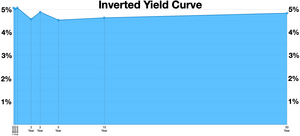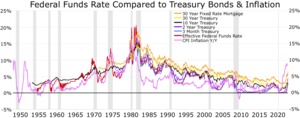




10 Year Treasury Bond
2 Year Treasury Bond
3 month Treasury Bond
Effective Federal Funds Rate
CPI inflation year/year
RecessionsIn finance, an inverted yield curve is a yield curve in which short-term debt instruments (typically bonds) have a greater yield than longer term bonds. An inverted yield curve is an unusual phenomenon; bonds with shorter maturities generally provide lower yields than longer term bonds.[2][3]
To determine whether the yield curve is inverted, it is a common practice to compare the yield on the 10-year U.S. Treasury bond to either a 2-year Treasury note or a 3-month Treasury bill. If the 10-year yield is less than the 2-year or 3-month yield, the curve is inverted.[4][5][6]
- ^ "US Treasurys". CNBC. September 25, 2012.
- ^ Bodie, Zvi; Kane, Alex; Marcus, Alan J. (2010). Essentials of Investments (Eighth ed.). New York: McGraw-Hill Irwin. pp. 315–317. ISBN 978-0-07-338240-1.
- ^ Melicher, Ronald W.; Welshans, Merle T. (1988). Finance: Introduction to Markets, Institutions and Management (7th ed.). Cincinnati OH: South-Western Publishing Co. p. 493. ISBN 0-538-06160-X.
- ^ "Bond Yields Reliably Predict Recessions. Why?". The Economist. 26 July 2018. Retrieved 31 May 2023.
- ^ Randall, David; Barbuscia, Davide (March 7, 2023). "Explainer: U.S. yield curve reaches deepest inversion since 1981: What is it telling us?". Reuters. Retrieved 27 May 2023.
- ^ Strauss, Lawrence C. "Yield-Curve Inversion Widens, Signaling More Recession Worries". Barron's. Dow Jones. Retrieved 28 May 2023.
© MMXXIII Rich X Search. We shall prevail. All rights reserved. Rich X Search
